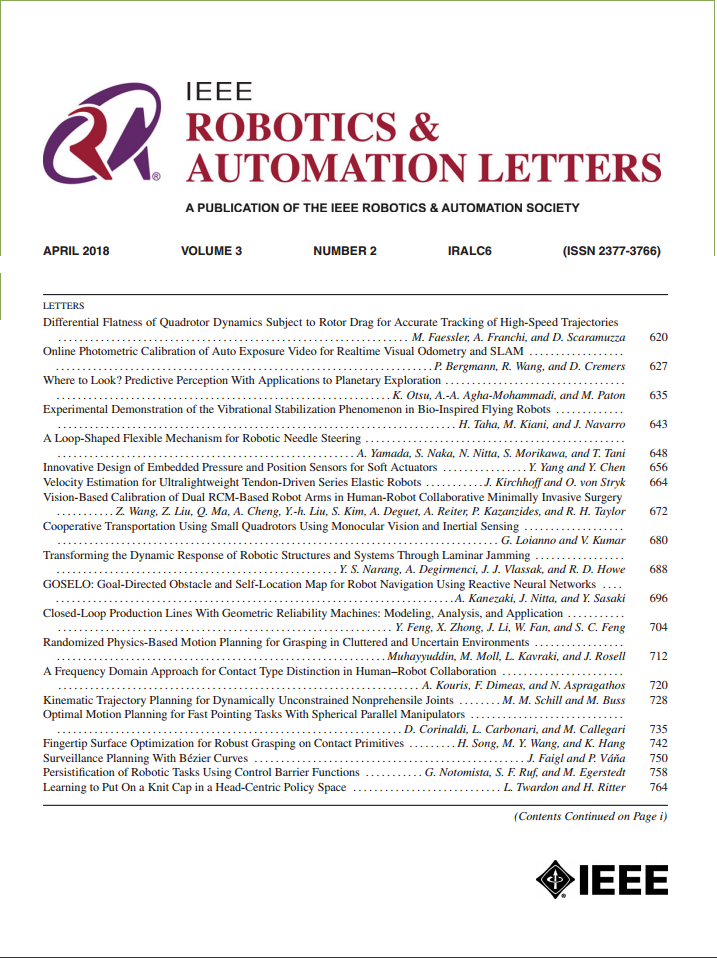CMIF-VIO: A Novel Cross Modal Interaction Framework for Visual Inertial Odometry
IF 4.6
2区 计算机科学
Q2 ROBOTICS
引用次数: 0
Abstract
Visual Inertial Odometry (VIO) estimates predicted trajectories through self motion. With the popularization of artificial intelligence, deep learning-based VIO methods have shown better performance than traditional geometry-based VIO methods. However, in deep learning methods, how to better achieve the fusion and complementarity between visual images from cameras and Inertial Measurement Unit (IMU) measurements from IMU sensors to output accurate pose remains a challenge. In this letter, we propose a novel Cross Modal Interaction Framework for VIO, named CMIF-VIO, which improves the accuracy of VIO and has good real-time performance. Specifically, we first used existing backbone network and built a simple backbone network to extract features from camera and IMU separately, ensuring low complexity. Then, we explored a cross modal interaction module that adaptively integrates information from different modal features, achieving deep interaction between visual and IMU modal features while maintaining feature dominance in each modal branch. Finally, a Long Short Term Memory (LSTM) network was introduced to model temporal motion correlation and output high-precision 6-degree-of-freedom (6-DOF) poses. The experimental results show that our method exhibits better performance compared to state-of-the-art VIO methods, and its real-time performance can meet the needs of practical application scenarios.CMIF-VIO:一种新的视觉惯性里程计跨模态交互框架
视觉惯性里程计(VIO)通过自运动估计预测轨迹。随着人工智能的普及,基于深度学习的VIO方法比传统的基于几何的VIO方法表现出更好的性能。然而,在深度学习方法中,如何更好地实现相机视觉图像与惯性测量单元(IMU)传感器测量结果之间的融合和互补,从而输出准确的姿态仍然是一个挑战。在这封信中,我们提出了一个新的VIO跨模态交互框架,命名为CMIF-VIO,它提高了VIO的精度,并具有良好的实时性。具体而言,我们首先利用现有的骨干网,构建一个简单的骨干网,分别从相机和IMU中提取特征,保证了低复杂度。然后,我们探索了一个跨模态交互模块,该模块可以自适应地整合来自不同模态特征的信息,实现视觉和IMU模态特征之间的深度交互,同时保持每个模态分支的特征优势。最后,引入长短期记忆(LSTM)网络建模时间运动相关,输出高精度6自由度位姿。实验结果表明,与现有的VIO方法相比,我们的方法具有更好的性能,其实时性可以满足实际应用场景的需求。
本文章由计算机程序翻译,如有差异,请以英文原文为准。
求助全文
约1分钟内获得全文
求助全文
来源期刊

IEEE Robotics and Automation Letters
Computer Science-Computer Science Applications
CiteScore
9.60
自引率
15.40%
发文量
1428
期刊介绍:
The scope of this journal is to publish peer-reviewed articles that provide a timely and concise account of innovative research ideas and application results, reporting significant theoretical findings and application case studies in areas of robotics and automation.
 求助内容:
求助内容: 应助结果提醒方式:
应助结果提醒方式:


